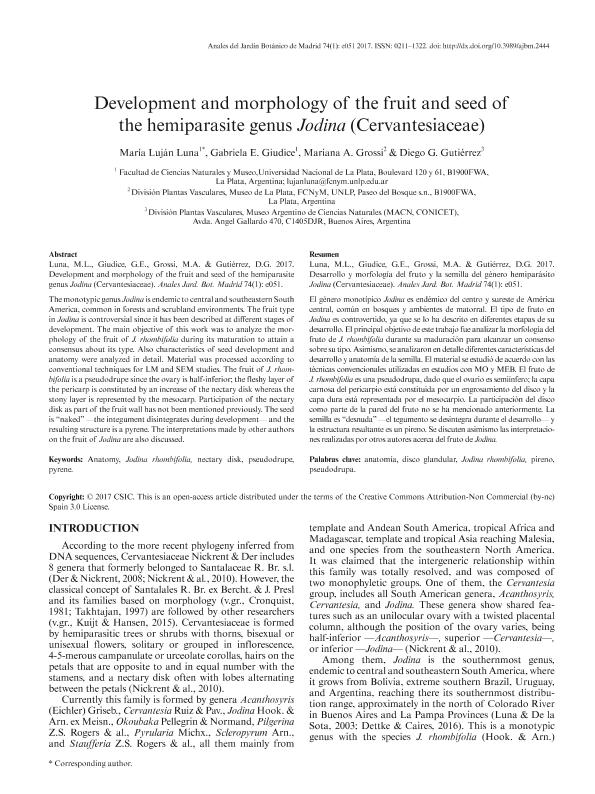Mostrar el registro sencillo del ítem
dc.contributor.author
Luna, María Luján

dc.contributor.author
Giudice, Gabriela Elena

dc.contributor.author
Grossi, Mariana Andrea

dc.contributor.author
Gutierrez, Diego Germán

dc.date.available
2019-01-09T17:13:44Z
dc.date.issued
2017-08
dc.identifier.citation
Luna, María Luján; Giudice, Gabriela Elena; Grossi, Mariana Andrea; Gutierrez, Diego Germán; Development and morphology of the fruit and seed of the hemiparasite genus Jodina (Cervantesiaceae); Consejo Superior de Investigaciones Científicas. Real Jardín Botánico; Anales del Jardín Botánico de Madrid; 74; 1; 8-2017; 1-9
dc.identifier.issn
0211-1322
dc.identifier.uri
http://hdl.handle.net/11336/67759
dc.description.abstract
El género monotípico Jodina es endémico del centro y sureste de América central, común en bosques y ambientes de matorral. El tipo de fruto en Jodina es controvertido, ya que se lo ha descrito en diferentes etapas de su desarrollo. El principal objetivo de este trabajo fue analizar la morfología del fruto de J. rhombifolia durante su maduración para alcanzar un consenso sobre su tipo. Asimismo, se analizaron en detalle diferentes características del desarrollo y anatomía de la semilla. El material se estudió de acuerdo con las técnicas convencionales utilizadas en estudios con MO y MEB. El fruto de J. rhombifolia es una pseudodrupa, dado que el ovario es semiínfero; la capa carnosa del pericarpio está constituida por un engrosamiento del disco y la capa dura está representada por el mesocarpio. La participación del disco como parte de la pared del fruto no se ha mencionado anteriormente. La semilla es “desnuda” —el tegumento se desintegra durante el desarrollo— y la estructura resultante es un pireno. Se discuten asimismo las interpretaciones realizadas por otros autores acerca del fruto de Jodina.
dc.description.abstract
The monotypic genus Jodina is endemic of central and southeastern South America,common in forests and scrubland environments. It belongs to the Cervantesiaceaefamily which includes eight genera that formerly belonged to Santalaceae s.l. Jodina rhombifolia is a hemiparasitic tree characterized by its rhombic and coriaceous leaf blades, glabrous surfaces, with a prominent spine at each vertex, and bisexual flowers with a nectary disk, a fleshy fruit and only one seed. The fruit type in Jodina is controversial since it has been described at different stages of development. The main objective of this work was to analyze the morphology of the fruit of J. rhombifolia during its maturation to attain a consensus about the fruit type. Also characteristics of seed development and anatomy which remained incomplete were analyzed in detail. Material was processed according to conventional techniques for LM and SEM studies. The fruit of J. rhombifolia is a pseudodrupe since the ovary is half-inferior; the fleshy layer of the pericarp is constituted by an increase of the nectary disk whereas the stony layer is represented by the mesocarp. Participation of the nectary disk as part of the fruit wall has not been mentioned previously. The seedis "naked" (the integument disintegrates during development) and the resultingstructure is a pyrene, sometimes mistaken in Santalaceae s.l. with the type of fruit nut. The interpretations made by other authors on the fruit type of Jodina are discussed.
dc.format
application/pdf
dc.language.iso
eng
dc.publisher
Consejo Superior de Investigaciones Científicas. Real Jardín Botánico
dc.rights
info:eu-repo/semantics/openAccess
dc.rights.uri
https://creativecommons.org/licenses/by-nc-sa/2.5/ar/
dc.subject
Anatomy
dc.subject
Nectary Disk
dc.subject
Jodina Rhombifolia
dc.subject
Pseudodrupe
dc.subject
Pyrene
dc.subject.classification
Otras Ciencias Biológicas

dc.subject.classification
Ciencias Biológicas

dc.subject.classification
CIENCIAS NATURALES Y EXACTAS

dc.title
Development and morphology of the fruit and seed of the hemiparasite genus Jodina (Cervantesiaceae)
dc.title
Desarrollo y morfología del fruto y la semilla del género hemiparásito Jodina (Cervantesiaceae)
dc.type
info:eu-repo/semantics/article
dc.type
info:ar-repo/semantics/artículo
dc.type
info:eu-repo/semantics/publishedVersion
dc.date.updated
2018-09-11T14:53:13Z
dc.journal.volume
74
dc.journal.number
1
dc.journal.pagination
1-9
dc.journal.pais
España

dc.journal.ciudad
Madrid
dc.description.fil
Fil: Luna, María Luján. Universidad Nacional de La Plata. Facultad de Ciencias Naturales y Museo. Cátedra de Morfología Vegetal; Argentina. Consejo Nacional de Investigaciones Científicas y Técnicas; Argentina
dc.description.fil
Fil: Giudice, Gabriela Elena. Universidad Nacional de La Plata. Facultad de Ciencias Naturales y Museo. Cátedra de Morfología Vegetal; Argentina
dc.description.fil
Fil: Grossi, Mariana Andrea. Universidad Nacional de La Plata. Facultad de Ciencias Naturales y Museo. División de Plantas Vasculares; Argentina. Consejo Nacional de Investigaciones Científicas y Técnicas; Argentina
dc.description.fil
Fil: Gutierrez, Diego Germán. Consejo Nacional de Investigaciones Científicas y Técnicas. Oficina de Coordinación Administrativa Parque Centenario. Museo Argentino de Ciencias Naturales “Bernardino Rivadavia”; Argentina
dc.journal.title
Anales del Jardín Botánico de Madrid

dc.relation.alternativeid
info:eu-repo/semantics/altIdentifier/url/http://rjb.revistas.csic.es/index.php/rjb/article/view/460
Archivos asociados
